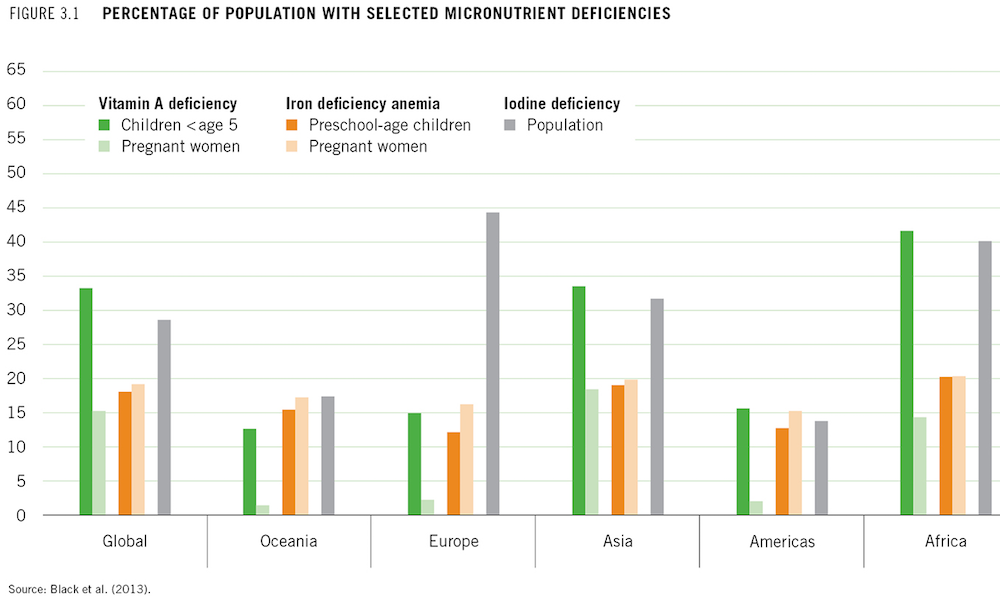Micronutrients
Mineral nutrients represent 4% of the body weight and micronutrients like iron, zinc and copper, only a few grams. But these nutrients are vital, as they participate in almost every biochemical reaction in our cells. Micronutrient deficiencies cause many different diseases and have global catastrophic consequences for human health, society and economies.
Whole grains have long since been important sources of macronutrients as carbohydrates and proteins. But grains as staple foods, are also important for access to micronutrients as vitamins and minerals. On a planet with an increasing population and diminishing resources, it becomes more important to make use of the nutrients in our food and to ensure that what we eat, contains everything we need.

Solutions used to prevent micronutrient deficiency
Varied diet
Varied diet is the reason deficiency diseases are more uncommon in the Western world, unlike populations that are heavily dependent on one staple crop.
Bioenrichment
Bioenrichment includes selections of crops through conventional plant breeding or through GMO (such as “golden rice”) to increase the nutrition in the primary product.
Enrichment
Enrichment of staple food with synthetic trace elements such as vitamins and inorganic mineral salts.
Supplements
Dietary supplements, such as additional vitamin D to children in Sweden or, as is common in developing countries, micronutrient powder, so-called MNP.
Bioprocessing
Bioprocessing activates enzymes and microorganisms through food processes such as malting, germination, soaking and sourdough fermentation, thus increasing the availability of micronutrients already existing in primary products.
Homeostasis and interactions
Micronutrients occur naturally in food in various functions. Minerals occur naturally in organic binds and many minerals have complex interactions with other minerals.
The body has a precisely regulated homeostasis (absorption, transport, storing and excretion), especially minerals. The biochemistry of the minerals are regulated by individual’s need. The absorption is dependent on the minerals ingested, organically bound as in natural foods, or inorganically bound salts, as in fortified iron and dietary supplements.
The absorption also depends on whether iron is bivalent Fe2+ i.e. meat or trivalent Fe3+ i.e. vegetables and if there is meat, vitamin C, phytate, coffee or tea. Other minerals such as calcium, copper, zinc and heavy metals also interact in the homeostasis.
The absorption of iron from fortified iron is at most 2–3%, from vegetables about 5–15%, depending on inhibitory factors such as phytate or stimulating factors such as vitamin C in the meal. The absorption from meat is 25%. For zinc absorption it is similar to iron and the absorption in an individual can, if the zinc status so demands, increase from 10% to 40% in a meal. A meal with a lot of phytate, 15% or less is absorbed. The absorption increases when the amount of phytate in the meal is reduced.
So minerals can either be absorbed or pass through the intestine depending on many factors. Supplements or minerals for fortification are often supplied as inorganic salts in unphysiological amounts. For common iron fortification the amount that can’t be absorbed (about 97%) may interact with zinc and copper or heavy metals, like cadmium in the intestines. The iron could donate electrons to free radicals and become carcinogenic. Also negatively affect the intestinal flora. In 1995 iron fortification of wheat flour in Sweden was stopped because it was considered unsafe.
In the US, a limit for total daily consumption of several minerals has been imposed and is also being discussed in the EU. By this means, supplements and fortifications can not be seen as an optimal way to supplying populations with micronutrients. Humans have, as nature, a complex biology and therefore it’s safer to use natural primary products as the source for our nutrients.

Vitamin and mineral contents in wheat (mg/100g)
Whole grain as staple food
50% of the human energy intake globally comes from wheat, rice and maize (corn). During the last 50-100 years, refined and nutritionally poor products of grains have taken over as the staple diet from traditional whole grain products. When polishing rice and refining wheat, 60–90% of the micronutrients are lost and our staple food becomes sources of empty calories.
It means that the bulk of staple food in the world has been depleted of its nutrients through the current treatment. This has great consequences for human health all over the world, for all classes of society, but mostly for economically exposed populations.
Dieticians and scientists nowadays agree that we need to have a mainly vegetarian diet that consists of vegetables and whole grains to keep us healthy, but also to be able to provide for the globe’s growing population.
Globally populations have foods originating from plants as staple foods and the consumption of vegetable staple food increases in the Western world. Whole grains are an unsurpassed source of energy, vital nutrients, even proteins, not to mention the fibers that we need for a good intestinal health. However whole grains also contain phytate that aggravates the bioavailability of these minerals and whole grains must therefore be revived.
Read more at The Whole Grains Council.
